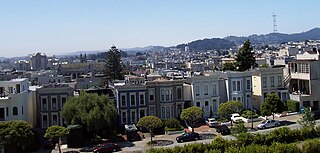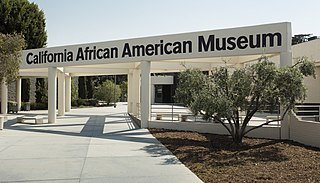
Berkeley is a city on the eastern shore of San Francisco Bay in northern Alameda County, California, United States. It is named after the 18th-century Anglo-Irish bishop and philosopher George Berkeley. It borders the cities of Oakland and Emeryville to the south and the city of Albany and the unincorporated community of Kensington to the north. Its eastern border with Contra Costa County generally follows the ridge of the Berkeley Hills. The 2020 census recorded a population of 124,321.

San Francisco, officially the City and County of San Francisco, is the commercial, financial, and cultural center of Northern California. With a population of 808,437 residents as of 2022, San Francisco is the fourth most populous city in the U.S. state of California behind Los Angeles, San Diego, and San Jose. The city covers a land area of 46.9 square miles at the upper end of the San Francisco Peninsula, making it the second-most densely populated major U.S. city behind New York City and the fifth-most densely populated U.S. county, behind four of New York City's boroughs. Among the 92 U.S. cities proper with over 250,000 residents, San Francisco is ranked first by per capita income and sixth by aggregate income as of 2022.As of 2023, the San Jose–San Francisco–Oakland, CA CSA is the 5th largest in the nation, with an approximate population of over 9,001,024.

Richmond is a city in western Contra Costa County, California, United States. The city was incorporated on August 3, 1905, and has a city council. Located in the San Francisco Bay Area's East Bay region, Richmond borders San Pablo, Albany, El Cerrito and Pinole in addition to the unincorporated communities of North Richmond, Hasford Heights, Kensington, El Sobrante, Bayview-Montalvin Manor, Tara Hills, and East Richmond Heights, and for a short distance San Francisco on Red Rock Island in the San Francisco Bay.

Alameda County is a county located in the U.S. state of California. As of the 2020 census, the population was 1,682,353, making it the 7th-most populous county in the state and 21st most populous nationally. The county seat is Oakland. Alameda County is in the San Francisco Bay Area, occupying much of the East Bay region.

Daly City is the second most populous city in San Mateo County, California, United States. The population was 104,901 at the 2020 census. Located in the San Francisco Bay Area, and immediately south of San Francisco, it is named for businessman and landowner John Donald Daly.

The Western Addition is a district in San Francisco, California, United States.

Pacific Heights is a neighborhood in San Francisco, California, United States. It has panoramic views of the Golden Gate Bridge, San Francisco Bay, the Palace of Fine Arts, Alcatraz, and the Presidio.

Berkeley City College is a public community college in Berkeley, California. It is part of the California Community Colleges System and the Peralta Community College District. Berkeley City College is accredited by the Accrediting Commission for Community and Junior Colleges.
Krouzian-Zekarian-Vasbouragan Armenian School is a bi-lingual private K-8 school in San Francisco, California.

Carmen Chu is an American politician serving as City Administrator of the City and County of San Francisco. She previously served as the city's assessor-recorder, where she was the only Asian-American assessor elected to serve among the 58 counties in the State of California. Prior to being elected assessor-recorder, Chu served as a member of the San Francisco board of supervisors, where she served two terms as the chair of the board's budget and finance committee, and was a board director of the Golden Gate Bridge, Highway and Transportation District. Before joining the board of supervisors, Chu served as deputy budget director in the mayor's office of public policy and finance. In July 2022, she was appointed to the Regents of the University of California by Governor Gavin Newsom.
The history of art in the San Francisco Bay Area includes major contributions to contemporary art, including Abstract Expressionism. The area is known for its cross-disciplinary artists like Bruce Conner, Bruce Nauman, and Peter Voulkos as well as a large number of non-profit alternative art spaces. San Francisco Bay Area Visual Arts has undergone many permutations paralleling innovation and hybridity in literature and theater.

George Magar Mardikian was a Turkish-born American restaurateur, chef, author and philanthropist of Armenian heritage. In 1938, he opened Omar Khayyam's restaurant in San Francisco, California, which was open for more than 40 years. He was important in popularizing Armenian cuisine in the United States. Mardikian was the founder of ANCHA. He is a nephew of Armenian revolutionary Krikor Amirian.
The Koret Foundation is a private foundation based in San Francisco, California. Its mission is to strengthen the Bay Area and support the Jewish community in the U.S. and Israel through grantmaking to organizations involved with education, arts and culture, the Jewish community, and the Bay Area community. The foundation takes an approach of testing new ideas and bringing people and organizations together to help solve societal and systemic problems of common concern.

Michael Yaki is an American attorney and politician. He has served as a Commissioner on the United States Commission on Civil Rights, succeeding Christopher Edley, Jr., since February 2005.

Laurence Monroe Baer is an American businessman. He is best known as the president and chief executive officer of the San Francisco Giants of Major League Baseball. He succeeded Bill Neukom on January 1, 2012.

African American Californians, or Black Californians are residents of the state of California who are of African ancestry. According to 2019 United States Census Bureau estimates, those identified solely as African American or black constituted 5.8% or 2,282,144 residents in California. Including an additional 1.2% who identified as having partial African ancestry, the figure was 7.0%. As of 2021, California has the largest multiracial African American population by number in the United States. African Americans are the fourth largest ethnic group in California after Hispanics, white people, and Asians. Asians outnumbered African Americans in the 1980s.

The San Francisco Bay Area comprises nine northern California counties and contains five of the ten most expensive counties in the United States. Strong economic growth has created hundreds of thousands of new jobs, but coupled with severe restrictions on building new housing units, it has resulted in a statewide housing shortage which has driven rents to extremely high levels. The Sacramento Bee notes that large cities like San Francisco and Los Angeles both attribute their recent increases in homeless people to the housing shortage, with the result that homelessness in California overall has increased by 15% from 2015 to 2017. In September 2019, the Council of Economic Advisers released a report in which they stated that deregulation of the housing markets would reduce homelessness in some of the most constrained markets by estimates of 54% in San Francisco, 40 percent in Los Angeles, and 38 percent in San Diego, because rents would fall by 55 percent, 41 percent, and 39 percent respectively. In San Francisco, a minimum wage worker would have to work approximately 4.7 full-time jobs to be able to spend less than 30% of their income on renting a two-bedroom apartment.
This is a timeline of the San Francisco Bay Area in California, events in the nine counties that border on the San Francisco Bay, and the bay itself.
The 2014 Oakland riots were a series of riots and civil disturbances that took place in Oakland, California and surrounding areas in November and December 2014. On November 24, 2014, following the decision of a Grand Jury in St. Louis to not charge Darren Wilson in the shooting death of black teenager Michael Brown, protests and rioting broke out in Oakland and later spread to other Bay Area cities. For more than two weeks, the Bay Area was the site of civil unrest as protesters clashed with police and damaged public and private property.
African Americans in San Francisco, California, composed just under 6% of the city's total population as of 2019 U.S. Census Bureau estimates, down from 13.4% in 1970. There are about 55,000 people of full or partial black ancestry living within the city. The community began with workers and entrepreneurs of the California Gold Rush in the 19th century, and in the early-to-mid 20th century, grew to include migrant workers with origins in the Southern United States, who worked as railroad workers or service people at shipyards. In the mid-20th century, the African American community in the Fillmore District earned the neighborhood the nickname the "Harlem of the West," referring to New York City's Harlem neighborhood, which is associated with African American culture.
















